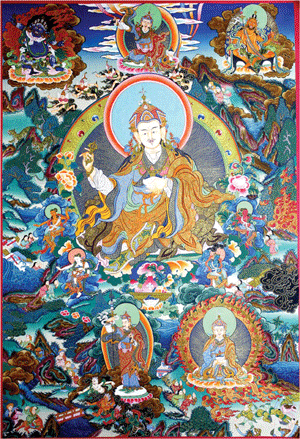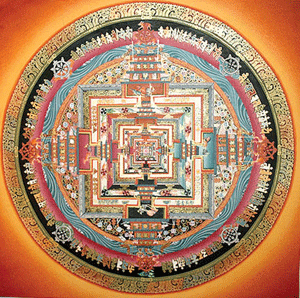
Thangka has always inspired people with awe owing to its complexity and religious significance. This form of religious painting that supposedly originated in Nepal around 11th century has many spiritual meanings that can be deciphered through its iconography.
But with growing commercialization of thangka painting, its meaning, spirituality and meditative functions has often been overlooked.
In the latest art discussion series held at Martin Chautari, Thapathali on May 25, a group of artists and artisans came together for a talk on thangka painting in the context of contemporary Kathmandu. The group discussed if these paintings have been reduced to mere aesthetic products bereft of originality.
The main speaker, artist Piero Passacantando from the US, has been studying the thangka painting — its methods, technique, iconography and philosophy for eight months now.
He pointed out some key points to be considered in the current context. As thangka essentially is a traditional and religious form of painting the question arises as to how it can retain centuries of accumulated tradition and at the same time be original.
He points out that with the youths being trained to paint thangkas; the art has become a labor instead of a vocation. But he also adds that it was amazing to see youths, who labored in thangka paintings, acquire such complex technical skills, which further helped their artistic impulses to produce meaningful pieces of art.
The group also discussed the authenticity and originality of thangka paintings. Sudarshan Suwal, a traditional thangka painter and Buddha Moktan, the President of Dharmadhatu Foundation, argue that first and foremost thangka is associated with spirituality. According to Suwal, the energy and spirituality attained through meditation when rendered into the canvas is what actual thangka is.
Whereas Suwal supports the traditionally used natural pigments as the authentic medium of thangkas, Uday Charan Shrestha, another thangka painter argues that medium does not make much difference. Though the Nepali thangka market has created such difference by claiming thangkas made with other colors besides stone colors as fake, the practice of using the natural stone pigments is less as it is very expensive. He also cited instances of how sellers deceived buyers by displaying natural stone colors but selling thangkas made of common pigments.

Moktan furthermore stresses on the accurate positioning and compositions of iconography and figures in the paintings. In Dharmadhatu foundation where Moktan and his group train youths to paint thangkas, he says that students are not forced to follow the strict set of guidelines of the iconography. But, on the other hand, he admits that true satisfaction of teaching is attained only when a student willingly toils under constraints and gets deeper into the meanings to recreate exact compostions.
Another topic of consideration was artists using the sacred iconography of thangkas in modern contemporary art. Passacantando is also working on his series entitled “Geometries” inspired from the thangka iconography and Buddhist philosophy.
He says, “I’ve sort of absorbed and internalized the knowledge I’ve acquired and tried to put it out in a different but a culturally respectful way.” As he believes that with just eight months of study and practice one cannot fully know the deeper meaning and use such sacred and religious iconography in one’s art recklessly.
Because the skill of thangka painting is acquired by repeatedly copying and passing on the same methods, placements and technique, it is debatable whether thangka painting is an art or a craft.
To this Piero puts in, as to when thangka or any other form of painting or sculpture transcends from craft to art is really dependent on individual judgement.
“There can be no line that divides these interconnected elements as art is in craft and craft in art.”
Source : http://www.myrepublica.com




